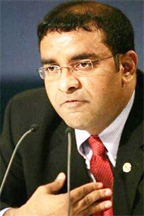-aiming for a million ducklings a year from NARI
A lack of political will in some CARICOM states has seen the region-wide agriculture initiative being stalled, President Bharrat Jagdeo says.

Despite identification of the interventions needed to transform regional agriculture, make the sector competitive and ensure the region is food secure, the objectives are not being met, said the President, who holds the agriculture portfolio in the Caribbean Community and spearheads the Jagdeo Initiative on Agriculture.
“There’s just been too much sloth in the region in the implementation of the Initiative for us to achieve the results that we set ourselves”, Jagdeo said in response to a question posed by this newspaper at a press conference on Friday at the Office of the President. “We simply can’t move the sector forward unless there is the political will to do so in the country”, he said while noting that this has to express itself in policies, incentives and specific budgetary allocations to tackle issues like drainage and irrigation and research and development. Unless these things are done, the objectives set out will not be met, he said. “Unfortunately, in some countries we haven’t seen the expression of that political will”, Jagdeo contended. He noted though that Jamaica and Trinidad have been doing a lot and in Guyana, the focus on agriculture has been tremendously accelerated.
The president will be in Rome for the World Food Summit this week and hopes to discuss the Region’s food issues. “I hope to…bring attention to the issue of food insecurity in our region because we have a huge potential for feeding ourselves but unless we ourselves start seeing this as a priority in all the countries of the region then we would likely remain as a net food importer from the rest of the world”, he declared. Jagdeo, acknowledging that more needs to be done for regional agriculture, said in meeting with the Food and Agricultural Organization, he will be asking for more resources from the developed world.
Nine binding constraints to regional agriculture, were identified in the Jagdeo Initiative including limited financing and inadequate new investment in agriculture. Others are outdated and insufficient agricultural health and food safety systems; inadequate research and development capacities. A fragmented and disorganized private sector; inefficient land and water-distribution and management systems; deficient and uncoordinated risk management measures; inadequate transportation systems, weak and non-integrated information and intelligence systems also characterize the sector while in terms of marketing, weak linkages and participation of producers in growth market segments; and lack of skilled and quality human resources were also identified. The President said that at the Summit, he would seek greater coherence in policies and institutions dealing with agriculture and specific help for the region to tackle the nine constraints.
A million ducklings
Meantime, in relation to Guyana’s agricultural thrust, the Head of State pointed to several initiatives such as a diversification programme. He said that there is now state support for a number of things citing, among other projects, a $75M scheme in 15 Amerindian communities in Region One that sees residents engaging in agricultural activities to meet their needs and which is going to be expanded and moved to other villages.
With renewed focus on the livestock industry and more state support through the National Agricultural Research Institute (NARI), the president also wants to see duck production fly. “I want a million ducklings produced per year”, he said noting that NARI had been given $30M to double the production of ducks. NARI has been criticized over the years for not doing enough.
Jagdeo said a lot of “real things” are happening and there are other projects in the pipeline. Government wants to work in collaboration with the University of the West Indies on a large scale tissue culture facility to obtain around 100,000 plants in six months and maintain quality. Jagdeo asserted that hopefully, the practical initiatives being pursued will, at the end of the day, make a big difference in local agriculture.
Large scale plantation-type agriculture is also being pursued. “We’re in discussion with three groups now that hopefully will end up in larger facilities”, Jagdeo said. He said that they are looking to the Rupununi for seed cultivation recalling meeting with Brazilian seed producers who said that for some varieties of rice they could get 15 tonnes per hectare compared to the 4.5 tonnes per hectare produced on the coast here. Production can be tripled without bringing new lands under control, Jagdeo said.
As regards an agriculture development bank being set up here, the President linked this to a growth in capacity. “We still have a fiscal deficit so the funds have to come from somewhere to do this and if our capacity grows at some point in time we may be able to do this”. He said that the World Bank’s Catastrophic Risk Insurance scheme is also being examined to determine whether flooding can be included. How crop insurance can be introduced here is also being examined.
“We’re trying to mitigate all the time the risks associated with agriculture”, said Jagdeo noting that for those involved in some sectors like those supplying canes to the Guyana Sugar Corporation, particularly at Skeldon, if farmers get a loan from the banking system “I’m prepared to extend the same treatment that mortgage financing has to those loans”. He explained that the income earned from those loans would be free of the corporate tax and this would allow the banks to lend for a longer period and a lower interest rate because of the benefit to the financial institutions.
